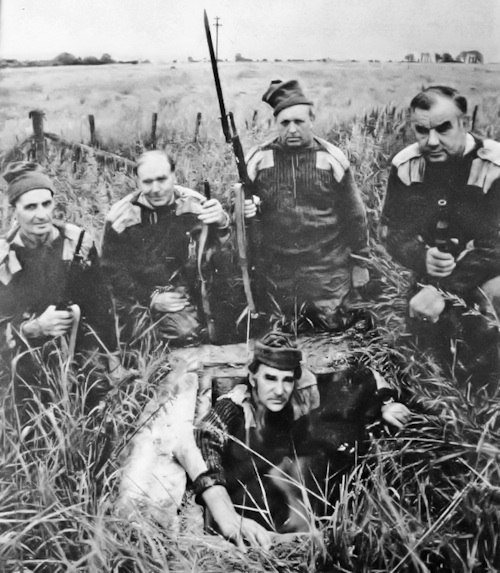Auxiliary Units
,
The closeness of Romney Marsh to the continent, its flat shores and hinterland, and easily accessible beaches, meant that the Marsh has been in the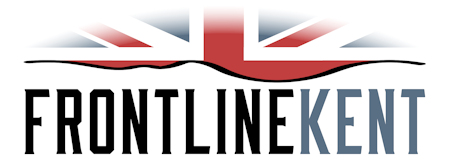
front line whenever invasion has threatened, particularly from across the English Channel. This was certainly the case in the Second World War when Romney Marsh was the planned invasion site of Operation Sea Lion, Germany's invasion plan of United Kingdom in 1940.
As part of the British government's plans to resist this expected occupation of the United Kingdom by Nazi Germany, they formed the Auxiliary Units These were specially trained, highly secret groups of volunteers who used the status of the Home Guard as a cover for their real activities.
Each Unit was a self-contained cell, expected to be self-sufficient and operationally autonomous in the case of invasion, generally operating within a 15-mile radius. Established in 1941, the units were about six men strong and when formed, were provided with a concealed underground Operational Base (OB), with a camouflaged entrance and emergency escape tunnel, to be used in the event of an invasion.
These hideouts were purpose-built to house the unit, well-hidden with the entrances camouflaged with wooden covers, and were supplied with the necessary food, water, ammunition and explosives.They It is thought that 400 to 500 such OBs were constructed.
The men chosen were trained to deal with explosives, weapon drill, cleanliness of weapons, firing and grenade throwing. The units would have attacked ammunition dumps, fuel dumps and vehicles.
Romney Marsh Auxiliary Unit Operational Bases
Three such units were known to operate on Romney Marsh, with Operational Bases (OB) at Snargate, Old Romney and Burmarsh, near Dymchurch.
- Snargate 'Mushroom' Patrol, located just off a footpath leading west from Snargate, 1 mile north west of Brenzett. Historic England Ancient Monuments
- New Romney 'Truffle' Patrol, located approximately 1/2 mile south of the ruins of Hope Church west of New Romney.
- Dymchurch 'Toadstool' Patrol, located 1 mile south of Chapel Farm, 2 miles north west of Dymchurch. Historic England Ancient Monuments
Each of the three operational bases were identical in size, being 20 ft long, 8 ft wide and 8 ft high. Because of the very high water table on the Marsh, the external walls were of reinforced concrete lined with bitumen, and white bricks were used on the inside. There was a ventilating downpipe in each corner and three air outlets along the centre of the chamber.
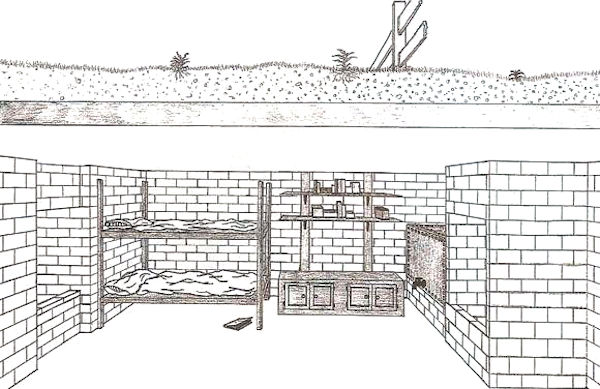
Drawing of the Snargate Auxiliary Unit bunker, which shows the general layout when it was operational.
Drawn by Jeremy Cole.
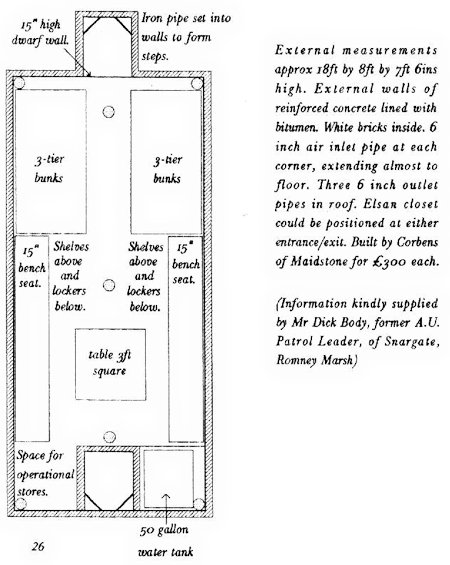
There was an entrance at either end, with dwarf walls at the bottom in case the enemy should drop a grenade into the entrance shaft. An Elsan closet was placed at one end, with two three-tier bunk beds; bench seats with shelves above and lockers below; a 50-gallon water tank; and a table. They were built by a civil contractor, Corben's of Maidstone, for £300 each.
The Auxiliary Units were stood down in 1944 when all threats of an invasion had passed. The underground hideout west of New Romney was blown up and filled in. The ones at Snargate and Eastbridge, now classed as war monuments, still remain.
Dymchurch 'Toadstool' Patrol Auxiliary Unit Operational Base Today (2016)
Located at the edge of a field off Chapel Lane in Burmarsh, the operational base for the Dymchurch 'Toadstool' Patrol is still well hidden but remarkably well intact. These pictures, taken in August 2016, show the outside, access and inside today with about 4 ins of water.
The auxiliary hide is a rectangular room 2.1m by 2.4m by 4.6m with brick-lined walls and a concrete floor and roof. It is concealed below-ground in the bank and is entered through 3.7m shafts at either end, iron bars in the brick work form steps down through each of the shafts into the room below.
The interior is separated from the entrance shafts by dwarf walls and retains its original water tank but no other fittings. There would originally have been two sets of three-tier bunk beds, a central table, benches and cupboards along the side walls. The original hatches have been replaced by later cast-iron hatches.
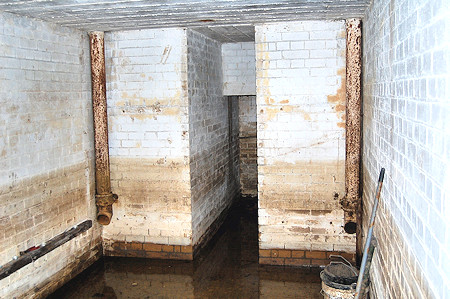
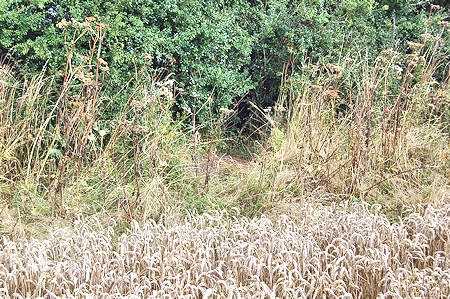
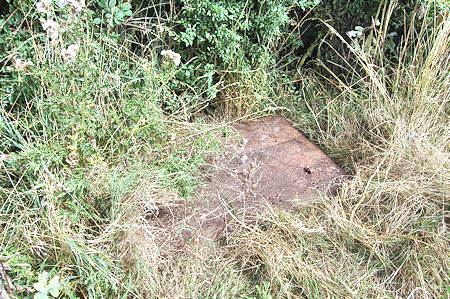
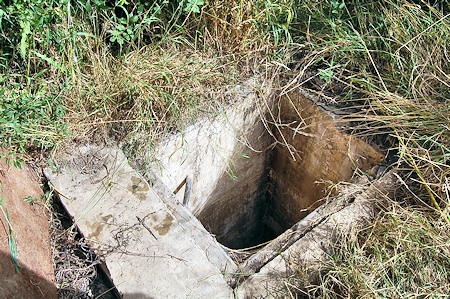
Snargate 'Mushroom' Patrol Auxiliary Unit Operational Base Today (2016)
Located at the edge of a field off Snargate Lane in Snargate, the operational base for the Snargate 'Mushroom' Patrol is still well hidden and inaccessible. As these picures, taken in September 2016, show the inside is completely flooded to about 6 ins from the top of the entrance.
The design and layout is identical to Dymchurch operational base.
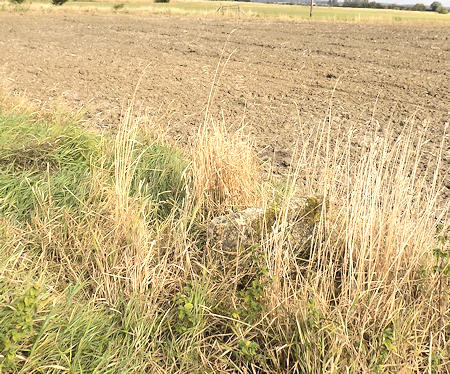
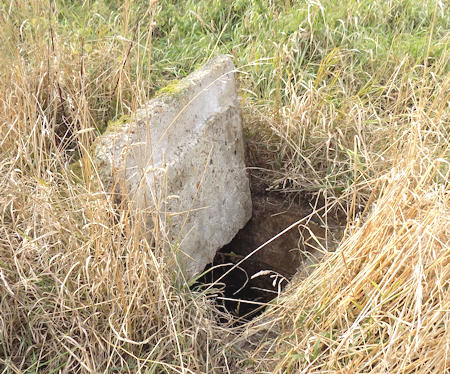
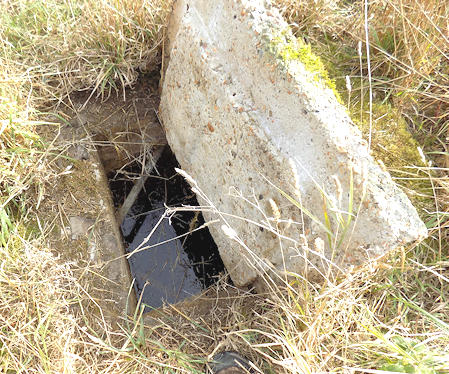
You can read the personal stories of some of the men involved in the three Romney Marsh operational bases in Romney Marsh at War by Edward Carpenter.
![]() Reference and more information
Reference and more information
You can read all about the Auxiliary Units in Churchill's Underground Army: A History of the Auxillary Units in World War II by John Warwicker.
![]() Local Resistance
Local Resistance
![]() More about World War II
More about World War II
![]() Invasion Coast
Invasion Coast
![]() History Homepage
History Homepage
Information courtesy of British Resistance Archive


















